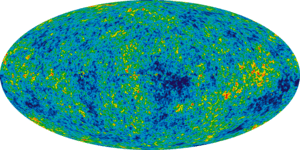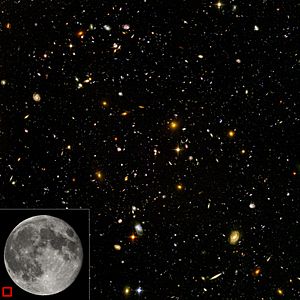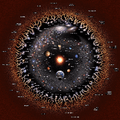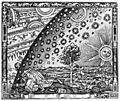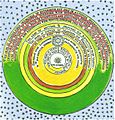Universe facts for kids
The Universe is everything that exists, has existed, and will exist. It includes all of space and time, and everything in it, like stars, planets, and huge clouds of gas.
Astronomers use powerful telescopes to look at very distant galaxies. This helps them see what the Universe looked like a long, long time ago. This is because light from far-off parts of the Universe takes a very long time to reach us. From what they see, it looks like the basic laws and rules of the Universe have always been the same.
Scientists are still trying to figure out if anything existed before the Big Bang. They also don't know if the Universe is endless in size.
Contents
How We Learned About the Universe
For a long time, people had different ideas about how the Universe worked. Many early ideas placed Earth at the very center. Some ancient Greeks thought the Universe was endless and had always been there. They imagined special spheres that held the stars, the Sun, and the planets, all circling a round, unmoving Earth.
Over hundreds of years, people made better observations. This led to Copernicus's idea that the Sun was actually at the center of our Solar System, not Earth. This idea was very new and caused a lot of debate, especially with religious groups. Famous thinkers like Giordano Bruno and Galileo faced challenges because of these new ideas.
The invention of the telescope in the Netherlands in 1608 was a huge step for astronomy. By the mid-1800s, telescopes were good enough to see other galaxies. Modern telescopes are even more amazing! Around the same time, Isaac Newton improved our understanding of gravity and how the Solar System moves.
In the 1900s, even better telescopes helped astronomers realize that our Solar System is just one tiny part of a huge galaxy called the Milky Way. They also discovered that countless other galaxies exist far beyond our own. This led to a new field called cosmology. Cosmologists study what these galaxies are made of and how they are spread out. This helps them learn more about the Universe's history and how it works. By measuring the redshift of galaxies, scientists like Hubble soon found out that the Universe is actually growing bigger!
The Big Bang Theory
The most accepted scientific idea about the Universe is the Big Bang theory. It says that the Universe started from a tiny, super-hot, super-dense point that held all the matter and energy. Then, it suddenly expanded very quickly.
There's a lot of scientific proof that supports the Big Bang idea. Astronomers believe the Big Bang happened about 13.73 billion years ago. Since then, the Universe has grown to be at least 93 billion light years across. It's still expanding right now, and that expansion is actually getting faster!
Scientists are still not sure what is making the Universe expand faster. They call this mysterious energy dark energy. By studying the Universe's expansion, astronomers also realized that most of the matter in the Universe can't be seen by our equipment. This unseen matter is called dark matter. Neither dark matter nor dark energy have been seen directly. But many astronomers think they must exist because many things we observe in space would be hard to explain without them.
Some parts of the Universe are expanding faster than the speed of light. This means their light will never reach us on Earth, so we can never see those parts. The part of the Universe we can see is called the observable universe.
What the Universe is Made Of
The word Universe comes from an old Latin word, universum. This word meant "everything rotated as one" or "everything rotated by one." This idea came from early Greek models where all matter was in rotating spheres around the Earth.
The Universe is usually thought of as everything that exists, has existed, and will exist. This means it's made of space and time, which together are called space-time. It also includes all the matter and different kinds of energy that fill space-time. All these parts follow physical laws that describe how they interact.
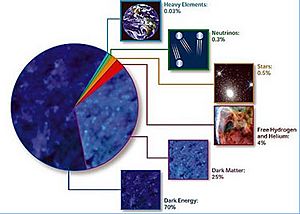

Facts About the Universe
The Universe is incredibly big, and it might even be endless. The matter we can see is spread across a space at least 93 billion light-years wide. To compare, a typical galaxy is only about 30,000 light-years across. The distance between two nearby galaxies is usually around 3 million light-years. For example, our Milky Way Galaxy is about 100,000 light-years wide. Our closest large galaxy, the Andromeda Galaxy, is about 2.5 million light-years away. The part of the Universe we can see has more than 2 trillion (2,000,000,000,000) galaxies! It also has an estimated 1,000,000,000,000,000,000,000,000 stars (that's more stars than all the grains of sand on Earth).
Galaxies can be small, with only ten million stars, or giant, with a trillion stars. All these stars orbit the center of their galaxy. So, a rough guess suggests there are around one sextillion (1021) stars in the observable Universe. A 2003 study even suggested there might be 70 sextillion (7 x 1022) stars!
The matter we can see is spread out evenly across the Universe when we look at very large distances (more than 300 million light-years). But on smaller scales, matter forms "clumps." Many atoms come together to form stars. Most stars are in galaxies. Most galaxies are in galaxy groups and clusters. The largest structures are like huge walls of galaxies.
The Universe's overall density (how much stuff is packed into a space) is very low. It's mostly made of 73% dark energy, 23% cold dark matter, and only 4% ordinary matter (the stuff we can see and touch). We don't know much about dark energy and dark matter. Dark matter slows down the Universe's expansion, while dark energy makes it speed up.
The Universe is old and always changing. Scientists estimate it's about 13.798 billion years old. This number comes from studying the cosmic microwave background radiation. Other ways of estimating the age, like radioactive dating, give similar results, from 11 to 20 billion years.
The Universe hasn't always been the same. Its expansion explains how we can see light from a galaxy 30 billion light-years away, even if that light has only traveled for 13 billion years. The space between us and the galaxy has expanded during that time. This expansion also explains why light from distant galaxies looks redshifted. This means the light waves have been stretched to longer wavelengths and lower frequency as they travel. The rate of this expansion is actually getting faster, based on studies of exploding stars called Type Ia supernovae.
The amounts of different chemical elements (especially light ones like hydrogen and helium) seem to be the same everywhere in the Universe and throughout its history. The Universe also seems to have much more matter than antimatter. It appears to have no overall electric charge, momentum, or angular momentum. Gravity is the strongest force over long distances in the Universe.
The Universe seems to have a smooth space-time continuum with three spatial dimensions (like length, width, height) and one time dimension. On average, space is very flat, meaning that basic Euclidean geometry works very well throughout most of the Universe. However, the Universe might have more dimensions, and its space-time might be connected in complex ways.
The Universe follows the same physical laws and physical constants everywhere. According to the main theory in physics, called the Standard Model, all matter is made of tiny particles called leptons and quarks. These particles interact through three main forces: the electroweak force (which includes electromagnetism and the weak nuclear force), the strong nuclear force, and gravity.
Ideas About the Universe
General Relativity
To accurately guess the Universe's past and future, we need a good theory of gravity. Albert Einstein's general relativity is the best theory we have. It has passed all tests so far. While we haven't done exact tests on the largest scales of the Universe, general relativity's predictions match what we observe. So, there's no reason to use a different theory.
General relativity uses a set of complex math equations to describe how space-time is shaped by the amount of mass-energy and momentum in the Universe. Since we don't know every detail, scientists use a "cosmological principle." This idea says that the Universe looks mostly the same everywhere and in every direction. This makes it easier to solve Einstein's equations and predict the Universe's past and future.
Einstein's equations include something called a cosmological constant. This is related to the energy of empty space. Depending on its value, this constant can either slow down or speed up the expansion of the Universe. Many scientists, including Einstein, thought this constant was zero. But recent observations of exploding stars show a lot of dark energy that is speeding up the Universe's expansion. This suggests the cosmological constant is not zero.
Big Bang Model
The Big Bang model explains many things we observe. For example, it explains why distant galaxies are redshifted (moving away from us) and why the Universe has a certain amount of hydrogen and helium. It also explains the cosmic microwave background radiation, which is like an echo from the early Universe. The redshift happens because space itself is expanding. As light travels through expanding space, its wavelength gets stretched, making it look redder. The longer light travels, the more it stretches.
Other observations can be explained by combining the Universe's expansion with nuclear physics and atomic physics. As the Universe expanded, it cooled down. This allowed tiny particles of matter to come together and form larger things. In the early Universe, protons and neutrons formed, which then made atomic nuclei. At this time, the Universe was a hot, dense plasma of electrons and nuclei. Nuclear reactions created the amounts of light nuclei we see today, like hydrogen, deuterium, and helium. Eventually, electrons and nuclei combined to form stable atoms. At this point, light could travel freely, creating the microwave radiation we see today.
There are still some things we don't fully understand. For example, why is there more matter than antimatter in the Universe? Also, evidence suggests that the Universe expanded extremely fast very early in its history, in a process called cosmic inflation. Recent observations also suggest that the cosmological constant is not zero, and that dark energy and dark matter make up most of the Universe's mass-energy. Dark matter slows expansion, while dark energy speeds it up.
Multiverse Idea
Some people think there might be more than one universe. They call this idea the multiverse. In this idea, each "universe" is separate and cannot affect the others.
The multiverse is not yet a scientific idea because there's no way to test it. An idea that can't be tested or isn't based on solid evidence isn't considered science. So, we don't know if the multiverse is a real scientific possibility.
The Universe's Future
The future of the Universe is a big mystery. However, scientists have a few ideas based on what shape they think the Universe might have:
- If the Universe is like a closed sphere, it might stop expanding. Then, it could start shrinking back down, becoming a tiny, super-dense point again. This idea is called the Big Crunch or Big Bounce.
- If the Universe is like an open sphere, it will keep speeding up its expansion. In billions of years, everything might get pulled apart by this force. This idea is called the Big Rip.
- If the Universe is flat, it will expand forever, but slower and slower. All stars will eventually run out of energy and become cold, dark dwarf stars. Even black holes will eventually disappear. This idea is called the Heat Death or Big Freeze.
Related pages
- Is there a hole in the universe? at HowStuffWorks
Videos
Images for kids
-
Television signals sent from Earth will never reach the edges of this image.
-
Astronomers have found stars in the Milky Way galaxy that are almost 13.6 billion years old.
-
How clusters and large filaments form in the cold dark matter model with dark energy. The pictures show how structures changed over 140 million light-years, from very early (upper left) to now (lower right).
-
Calculations from the 3rd century BCE by Aristarchus showing the sizes of the Sun, Earth, and Moon. This is from a Greek copy made in the 10th century AD.
-
A model of the Copernican Universe by Thomas Digges in 1576. It shows stars not just in a sphere, but spread out around the planets.
-
A map of the superclusters and empty spaces closest to Earth.
See also
 In Spanish: Universo para niños
In Spanish: Universo para niños


